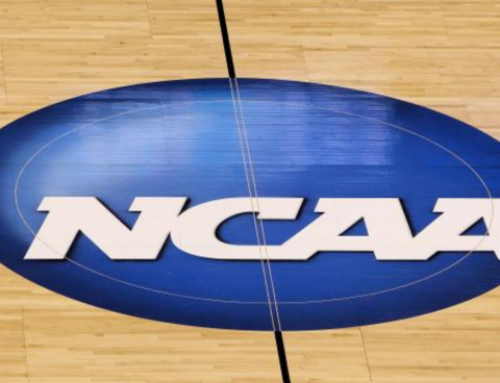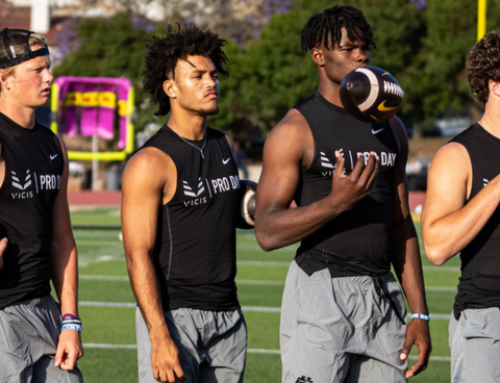Terrell Davis Had Just One Scholarship Offer After High School. Now He’s in the Hall of Fame
Coming out of Lincoln High School in San Diego, California, Terrell Davis was about as unheralded a recruit as one can be.
When he first joined the team during his junior season, the running back spot—Davis’s position of choice since youth football—was filled. For the next two years, he’d rotate between nose guard, tight end, guard, kicker and fullback. While Davis was a good athlete, his stats were far from spectacular and many college coaches didn’t see a natural position fit for him.
“I was nothing there,” Davis told The Augusta Chronicle of his time at Lincoln. By the time signing day rolled around, he had just one offer—Long Beach State University. And the only reason they offered was because Terrell’s older brother, Reggie, played tailback at the school and persuaded the staff to give him a scholarship.
The team was coached by George Allen, who had previously served as the head coach for the Washington Redskins and was inducted into the Pro Football Hall of Fame in 2002. While Davis redshirted his freshman year, Allen saw great promise in him as the scout team running back. He nicknamed Davis Secretariat (a champion racehorse who won the Triple Crown in 1973) due to his strong, smooth running style.
LBSU went 6-5 that season and Davis was pegged as one of Allen’s rising stars. For the moment, everything seemed like it was going to turn out alright for TD. Then, tragedy struck—Allen passed away that offseason.
Though Davis got some playing time the next year, the reeling program went 2-9. The team was then disbanded due to financial issues and declining fan support. Davis found out he no longer had a team when a fellow student informed him of the decision while he was on his way to class.
Luckily, Davis had put enough on tape that some programs were willing to give him a shot. The University of Georgia was one of those schools, and despite the fact Davis couldn’t pick out the peach state on a map, he took a visit. Enamored by the excellent facilities and strong tradition, Davis transferred to UGA. He was initially blocked on the running back depth chart by Garrison Hearst, who finished third in the 1992 Heisman Trophy voting.
As a redshirt junior, Davis emerged as the team’s lead back, rushing for 824 yards and 5 touchdowns. Once again, his career looked to be on the rise. He then suffered two hamstring tears and saw his role greatly reduced as Ray Goff, the team’s head coach, moved to a more passing-oriented attack.
When it came time for a different type of recruitment—the 1995 NFL Draft—Davis was once again largely overlooked. Sixteen running backs and four fullbacks were drafted ahead of him. The Denver Broncos eventually drafted Davis with the 196th overall pick. When he came to training camp for his rookie season, he was listed as the sixth running back on the team’s depth chart.
“If there had been 20 runnings back (on the team), he would have been 20th,” Bobby Turner, the team’s running backs coach, told Sporting News.
But the coaches started to see something in Davis. Not only was he strong and fast, but he had a strong passion for the game. Perhaps all those ups-and-downs on his way to the NFL, all those times where it looked like his playing career might be over, had something to do with that passion. A thunderous special teams tackle during the team’s final preseason game in Tokyo, Japan gave Davis confidence and upward momentum on the depth chart:[youtube video=”s0rjMNo3DoI”]
By the first game of the regular season, he was the team’s starting running back. That launched a Hall of Fame career that included two Super Bowl rings, three first-team All-Pro selections and the 1998 NFL MVP award. Not bad for a kid who had one offer coming out of high school. To this day, Davis cannot believe the way his career played out.
His advice to young athletes?
“My advice (to young athletes) is don’t look at where you are right now and make the decision whether you can make it or not. The worst thing you can do is say, ‘you know what, I’m the backup running back or I’m the backup quarterback,’ and use that as a reason you can’t go any further. We’ve seen, not only from my story, but from Kurt Warner’s story and so many other guys’ stories, we don’t know how it’s going to turn out,” Davis says. “The only thing you can do is when you get a chance and wherever you land, just play and be the best you can be. It’s as simple as that. Work hard, be prepared and try to go out everyday and—this is with everything in life—be the best you can be. If you’re doing that, and being true to who you are, your path to success continues.”
Photo Credit: Focus on Sport/Getty Images
READ MORE:
RECOMMENDED FOR YOU
MOST POPULAR
Terrell Davis Had Just One Scholarship Offer After High School. Now He’s in the Hall of Fame
Coming out of Lincoln High School in San Diego, California, Terrell Davis was about as unheralded a recruit as one can be.
When he first joined the team during his junior season, the running back spot—Davis’s position of choice since youth football—was filled. For the next two years, he’d rotate between nose guard, tight end, guard, kicker and fullback. While Davis was a good athlete, his stats were far from spectacular and many college coaches didn’t see a natural position fit for him.
“I was nothing there,” Davis told The Augusta Chronicle of his time at Lincoln. By the time signing day rolled around, he had just one offer—Long Beach State University. And the only reason they offered was because Terrell’s older brother, Reggie, played tailback at the school and persuaded the staff to give him a scholarship.
The team was coached by George Allen, who had previously served as the head coach for the Washington Redskins and was inducted into the Pro Football Hall of Fame in 2002. While Davis redshirted his freshman year, Allen saw great promise in him as the scout team running back. He nicknamed Davis Secretariat (a champion racehorse who won the Triple Crown in 1973) due to his strong, smooth running style.
LBSU went 6-5 that season and Davis was pegged as one of Allen’s rising stars. For the moment, everything seemed like it was going to turn out alright for TD. Then, tragedy struck—Allen passed away that offseason.
Though Davis got some playing time the next year, the reeling program went 2-9. The team was then disbanded due to financial issues and declining fan support. Davis found out he no longer had a team when a fellow student informed him of the decision while he was on his way to class.
Luckily, Davis had put enough on tape that some programs were willing to give him a shot. The University of Georgia was one of those schools, and despite the fact Davis couldn’t pick out the peach state on a map, he took a visit. Enamored by the excellent facilities and strong tradition, Davis transferred to UGA. He was initially blocked on the running back depth chart by Garrison Hearst, who finished third in the 1992 Heisman Trophy voting.
As a redshirt junior, Davis emerged as the team’s lead back, rushing for 824 yards and 5 touchdowns. Once again, his career looked to be on the rise. He then suffered two hamstring tears and saw his role greatly reduced as Ray Goff, the team’s head coach, moved to a more passing-oriented attack.
When it came time for a different type of recruitment—the 1995 NFL Draft—Davis was once again largely overlooked. Sixteen running backs and four fullbacks were drafted ahead of him. The Denver Broncos eventually drafted Davis with the 196th overall pick. When he came to training camp for his rookie season, he was listed as the sixth running back on the team’s depth chart.
“If there had been 20 runnings back (on the team), he would have been 20th,” Bobby Turner, the team’s running backs coach, told Sporting News.
But the coaches started to see something in Davis. Not only was he strong and fast, but he had a strong passion for the game. Perhaps all those ups-and-downs on his way to the NFL, all those times where it looked like his playing career might be over, had something to do with that passion. A thunderous special teams tackle during the team’s final preseason game in Tokyo, Japan gave Davis confidence and upward momentum on the depth chart:[youtube video=”s0rjMNo3DoI”]
By the first game of the regular season, he was the team’s starting running back. That launched a Hall of Fame career that included two Super Bowl rings, three first-team All-Pro selections and the 1998 NFL MVP award. Not bad for a kid who had one offer coming out of high school. To this day, Davis cannot believe the way his career played out.
His advice to young athletes?
“My advice (to young athletes) is don’t look at where you are right now and make the decision whether you can make it or not. The worst thing you can do is say, ‘you know what, I’m the backup running back or I’m the backup quarterback,’ and use that as a reason you can’t go any further. We’ve seen, not only from my story, but from Kurt Warner’s story and so many other guys’ stories, we don’t know how it’s going to turn out,” Davis says. “The only thing you can do is when you get a chance and wherever you land, just play and be the best you can be. It’s as simple as that. Work hard, be prepared and try to go out everyday and—this is with everything in life—be the best you can be. If you’re doing that, and being true to who you are, your path to success continues.”
Photo Credit: Focus on Sport/Getty Images
READ MORE:
RECOMMENDED FOR YOU
Create A Free Recruiting Profile Today!
CaptainU helps athletes & parents not only be proactive but also to manage and take control of their entire recruiting journey.










